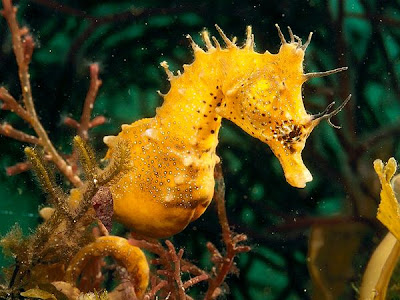Click here for the 'Seeds of Eaden' seed shop
Seahorse is the title given to forty-seven species of marine fish in the genus Hippocampus. "Hippocampus" comes from the Ancient Greek hippos meaning "horse" and kampos meaning "sea monster".
Kingdom: Animalia
Phylum: Chordata
Class: Actinopterygii
Order: Syngnathiformes
Family: Syngnathidae
Subfamily: Hippocampinae
Lower classifications: Pygmy seahorse, Fisher's seahorse, Sea pony, West African seahorse, Narrow-bellied seahorse, Barbour's seahorse, Réunion seahorse, Knobby seahorse, Giraffe seahorse, Cape seahorse, Tiger tail seahorse, Crowned seahorse, Denise's pygmy seahorse, Long-snouted seahorse, Pacific seahorse, Jayakar's seahorse, Great seahorse, Common seahorse, Lichtenstein's seahorse, Bullneck seahorse, Japanese seahorse, Longsnout seahorse, Shiho's seahorse, Hedgehog seahorse, Tiger snout seahorse, Flat-faced seahorse, New holland seahorse, Zebra seahorse, Dwarf seahorse, Short-snouted seahorse, Big-head seahorse, Hippocampus histrix, Big-belly seahorse
1. Seahorses are fish
After much debate over the years, scientists finally that seahorses are fish. They breathe using gills, have a swim bladder to control their buoyancy, and are classified in the Class Actinopterygii, the bony fish, which also includes larger fish such as cod and tuna. The seahorse is a member of the pipefish family, belonging to the order Gasterosteiformes, family Syngnathidae and species Hippocampus.
2. There are thirty-five species of seahorse
There are many species of seahorse ranging in size from a 2.5 cm pigmy variety to the giant 35 cm Eastern Pacific seahorse.
3. Seahorses mate for life
Many seahorses are monogamous. The male and female have an elaborate, daily courtship ritual, involving a "dance" where they entwine their tails, and may change colors.
4. Seahorses can change colour
The seahorse escapes the attention of predators by developing long skin filaments and camouflage colouration to match the marine weed in which it lives. Within a matter of seconds it can change from grey or black to bright orange, vivid yellow or even deep plum.
5. The seahorse male has a true reversed pregnancy
In seahorses it is the male who takes on the responsibility of pregnancy. This allows the females to make more eggs straight away without the need to nurture the last batch. In a reverse of roles, because the male limits the rate of reproduction, the females compete with each other for the attention of the males. The babies are born as perfect miniatures of their parents.
6. Seahorses can be found in Britain
There are two species around British Coastline, the Spiny Seahorse (Hippocampus Guttulatus and the Short Snouted Seahorse (Hippocampus Hippocampus). Seahorses are usually found in warm, shallow water amongst sea grass beds. While some species prefer muddy or sandy areas, others can be found hanging onto corals, sponges, mangrove roots or even wrapped around the mooring ropes of boats.
7. They can look forward and backwards at the same time
Seahorses can move their eyes independently and so can follow the activity of passing tiny sea life without giving their presence away. When they judge that their prey is within range they quickly snap it up or suck it in from as much as 3 cm away.
They rely on their dorsal fin beating at 30-70 times per second to propel it along. Pectoral fins either side of the head help with stability and steering. Their tails are prehensile; that is they are specially adapted for grasping. To avoid being swept away by the current they wrap their tails around nearby vegetation.
9. Seahorses feed constantly.
They feed on plankton and small crustaceans. They do not have a stomach, so food passes through their bodies very quickly, and they need to eat nearly constantly.
10. Seahorses have an exo-skeleton
Unlike most other fish, seahorses do not have scales and their bodies are made up of hard, external, bony plates that are fused together with a fleshy covering.
For related articles click onto:
All about starfishCan starfish grow back their arms?
How many seas are there in the world?
Is the sea sponge a plant or an animal?
Keystone species
Sea animals: Sea Anemones
Sea cucumber facts
Seahorse facts
Star Starfish
The seahorse
The sea cucumber
What is a sea sponge?
What is a cuttlefish?
What is a sea anemone?
What is a starfish?
Why is the Dead Sea so salty?
What is the difference between the sea and the ocean?
What is the Gulf Stream?





This comment has been removed by a blog administrator.
ReplyDelete